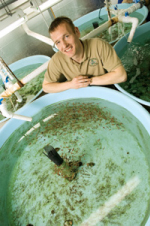 |
|
| Søren Hansen | |
The foundation for building a marine ornamental aquaculture industry in Maine has been established. The prospect of "saving the coral reefs" while promoting a new economy in Maine led to the creation of a Marine Ornamental Research Laboratory at the University of Maine in October 2003. The laboratory consists of a state-of-the-art broodstock facility, a quarantine lab, larval rearing and grow-out systems, a zooplankton rearing lab and a live algae room. The facility is used by several faculty members, laboratory technicians, graduate and undergraduate students.
Sea & Reef Aquaculture, LLC was established in March 2003, as a spin-off to the research conducted at UMaine (Orono campus) and to demonstrate the economically feasibility of marine ornamental fish production in Maine. The company is currently owned by UMaine Ph.D. Candidate Soren Hansen and is incubated at the ARC facility. The company has successfully and consistently cultured and sold 11 species of marine ornamental fish including species of clownfish, dottybacks, and recently seahorses, to retail pet stores across the nation.
Research has been initiated by Mr. Søren Hansen to solve the bottleneck problems for mass rearing of pelagic spawning fish. Multiple pairs of pelagic spawning flame angelfish have been conditioned and are now spawning consistently in the lab. Species of various first feed zooplankton prey organisms have been identified, isolated and are presently cultured at the ARC. We are now able to initiate the next phase, which will be optimizing the rearing environment and developing feeding protocols for fish larvae.
Classroom Exercises | Content Links

